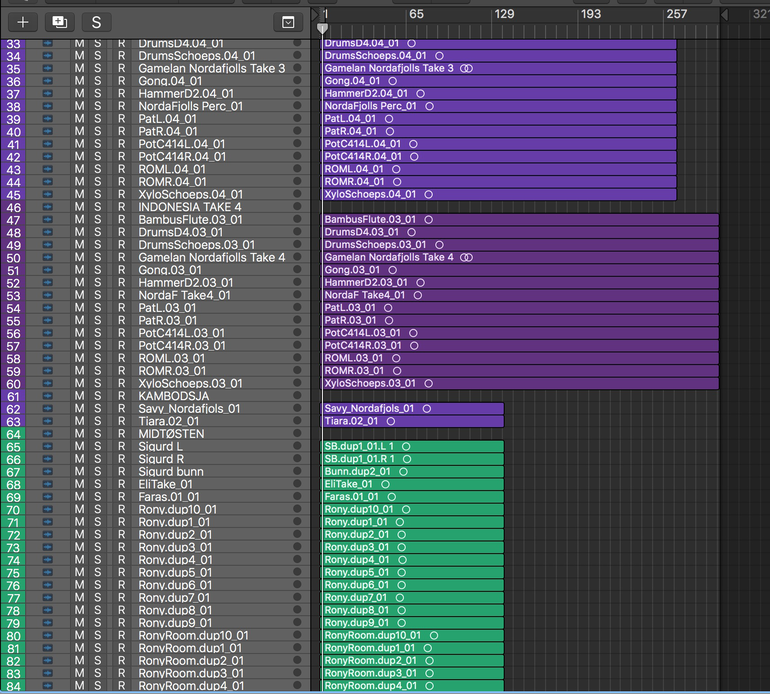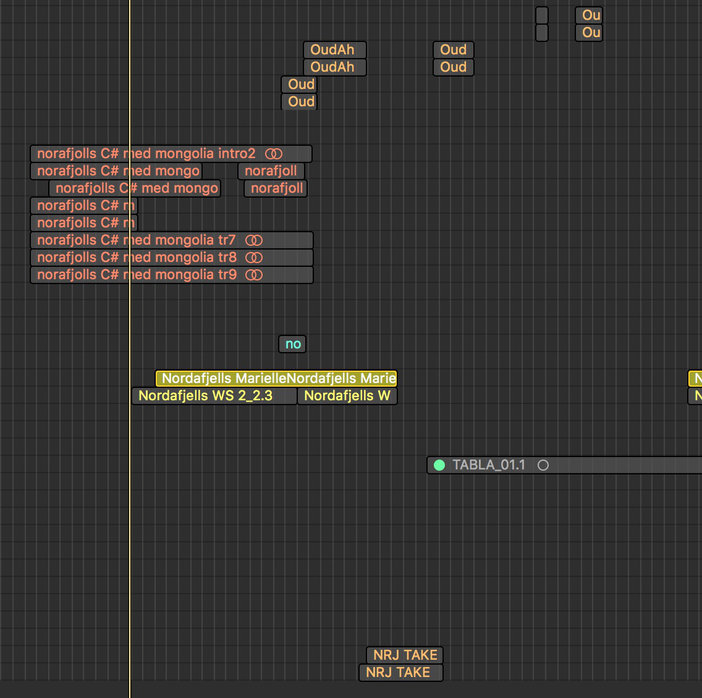Phase 7: Arranging and editing, methods and hard choices (Winter/Spring 2017)
Each musician had given us their response to the source with minimal responses to other responses, since we wanted to keep every option open regarding the arrangements. This dogmatic method creates a challenge: How can it be organised into arrangements, yet remain true to the sources and responses given? We ended up with up to 140 tracks of different responses to one source. Playing all of the tracks at once sounds like a cacophony and a wall of sound in which it is impossible to distinguish the different artists:
We needed to create an arrangement or a timeline in order to manage this giant musical puzzle. As project leaders, we now made out musical responses, bringing in organ/synth and piano into the mix in order to bind it together and support the harmonies already implied in the scales played and sung. This is ethically questionable, since there is a danger that we might alter the instruments to fit our sound structure and harmonies. On the other hand, we possess extensive knowledge and a wide range of experiences combining Western and traditional instruments. We have been involved in the process from day one, and know all the participants and music recorded. Of course an argument could be made that we are too close to the material and blinded to other potential solutions than our own. Nevertheless, we do recognise that an arrangement can be done in many ways, but at some point decisions have to be made.
The aim of this phase is not to accentuate ourselves as musicians or arrangers, but to provide a musical environment for the sources and responses, and give them a musical context that would give each of them a focus. The format of the CD is limited to 60 minutes. Nowadays, online solutions may seem like a better choice with an unlimited time frame, but outside Europe and parts of USA, CDs are for now still the preferred format. The phonogram will, however, be made available for streaming on a wide range of digital platforms.
The project leader, who also is the main producer, stated that every piece should ideally tell us a story, and some of the tracks ended up lasting for up to twelve minutes – hardly a pop production. Nevertheless, the Norwegian record company, Grappa, has agreed to release the album in October, ensuring worldwide publication of the release and exposure through their networks.
Here are a small excerpt from a Studio session in progress with the tune Nordafjells, who had 204 tracks in total before editing..
Our colleagues at UiA, Rolf Kristensen (electric guitar) and Fredrik Salander (bass) joined in as Norwegian responses as the arrangements developed. Kristensen, although an experienced studio musician, commented the awareness and precense he felt giving a one-take response to the 11 minutes track Guds Godhet, without having heard anything of the music previously.
Back in Setesdal we gathered the four sources at Sylvartun for one day of live studio responses and a presentation of the arrangements close to their final form. None of the artist had heard the music since we recorded them in 2014. Kirsten and Sigurd did responses, while all four sources actively commented and questioned our choices and repertoire. They all wanted more of the harding fiddle tunes since the arrangement of several tunes were not finished at the present time. We did send them at a later stage to Hallvard and Gunnar for their approval. The balance of the repertoire on the CD do feature more songs with vocals, as it reflects the amount of response material in the project. Here are Sigurd Brokke doing a live response:
Regarding copyrights, we, as project leaders, producers, musicians and arrangers, will not claim any rights. 100% is to go to the sources and responses. It is an almost impossible task to divide the percentage fairly between all the participants since so many musicians and artists are involved. Therefore, we wrote an email asking for approval from every musician and artist agreeing accept an equal share song by song: If 20 people perform on one song, they each get 5%. If five people perform on another song they get 20% each. In theory, this is fair, but most outside Europe do not get to see any of this royalty income since there is no national organisation to claim the copyrights. Each country needs to have an organisation for this, such as TONO in Norway, or SACEM in Europe. Copyright payments are based on CD-sales and radio play. Neither are likely to generate any income of significance as, in the case of streaming, you need at least millions of streams to see any significant income. However, there are no other possibilities for us to credit appropriately in any other way, for the time being.
Publishing rights (sync copyrights for film and multimedia) will be handled by Grappa. In the unlikely event that income should be generated, the royalties will be split: 50% to Grappa and 50% to the musicians and artists contributing to the tune in question. The tune itself will not be sold; there is a specific, limited license for use. The 50/50 split is the usual deal regarding publishing rights, as it is the record company with the connections and which spends time and effort disseminating it into various media markets. Grappa will pay out to each musician or artist involved. The alternative would be 100% to the artists and musicians for publishing rights. But who, in which case, would sell to the film industry? We simply do not have the connections to do this – so the alternative is, in fact, 100% of nothing. From this point of view, we believe that 50% of something is a better option, since this money will actually reach all the responses involved, in contrast to the copyright royalties.
Every artist and musician will be credited correctly according to their participation in the CD-booklet for each song, and these details will be stated clearly.

